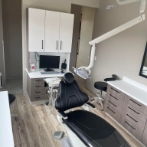
Did you know that gaps in your grin can impact more than just your appearance? If your teeth are too small for your mouth or your jawbone too large, you are more likely to have wider areas of uncovered gum tissue. This can make you self-conscious about your looks or overly worried about how others perceive you. In addition to that, bits of food and other debris can quickly become lodged there, lacerating the tender tissue and contributing to oral issues like cavities and gum disease.
Many patients wonder whether dental bonding can be used to address spaces in their smiles, especially in more visible spots. Thankfully, in certain situations, it can! Continue reading to learn about 3 conditions that can be remedied with this procedure!
#1: Problems with Upper Teeth
You may not realize it, but the teeth in your upper jaw are larger and have more surface area to work with. That means it’s easier for your dentist to apply and bond the material to your pearly whites in a way that looks and feels lifelike. It’s still possible for them to apply this fix to your lower arch, but other solutions, like porcelain veneers, might be more appropriate.
#2: Minor Gaps
This method is best for those with insignificant gaps in their grins. To help your smile look more aligned, your dentist applies custom-colored composite resin that is then molded into the ideal shape. This essentially bulks up your teeth to close minor spaces between them.
If you have more severe misalignment issues, your provider might recommend a suitable orthodontic treatment, like ClearCorrect clear aligners or traditional braces. These treatments exert enough pressure on your chompers to gently shift them to their rightful places rather than altering their size to improve your oral health.
#3: Good Oral Health
Dental bonding adheres to your enamel directly, meaning that your teeth need to be mostly healthy for it to be effective. If yours are riddled with decay, disease, or other damage, there might not be enough viable material to support the repair. Maintaining the results also involves a dedication to your daily dental hygiene. This solution can last 10+ years, but only if you brush and floss consistently and visit your dentist for a routine checkup and cleaning every six months.
If you’re still unsure of the best way to address imperfections in your smile, the best way to find out is to schedule a consultation with your dentist!
About the Author
Dr. Kara Arnold feels inspired by helping people build and maintain their most beautiful, healthy smiles. She earned her DDS from the University of Illinois at Chicago and has continued her education to stay on top of the latest advancements in dental technology and techniques. She’s experienced in providing a full range of services, including complex restorative procedures, conveniently under one roof. If you’d like to upgrade your grin, you can request a consultation on the website or call (303) 268-2965.




